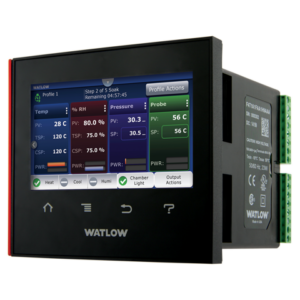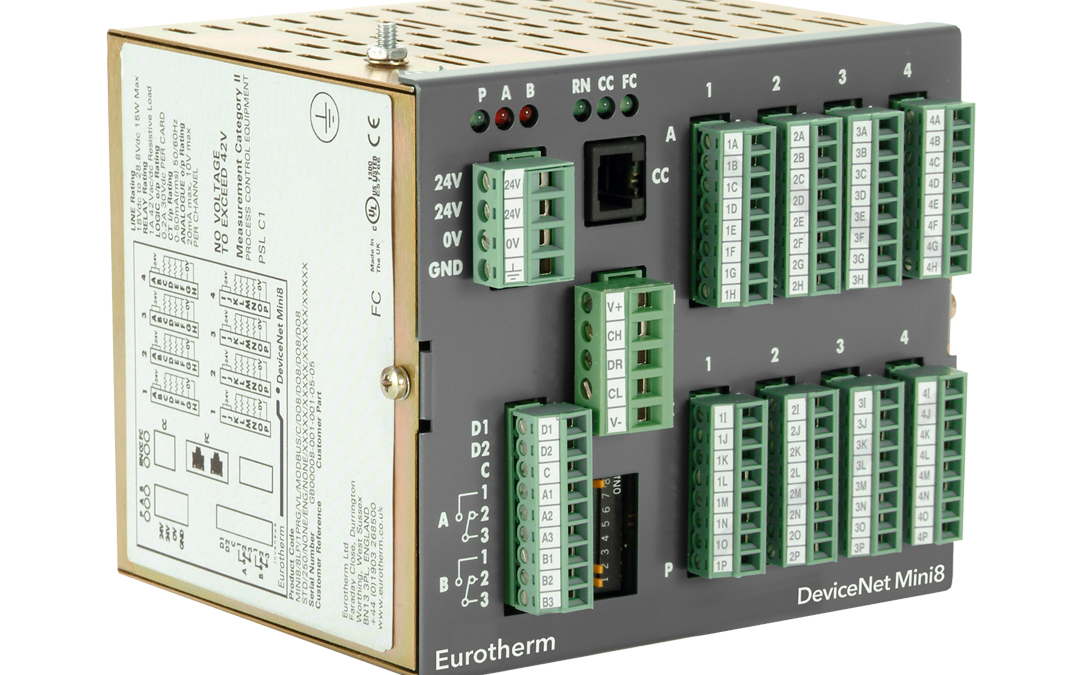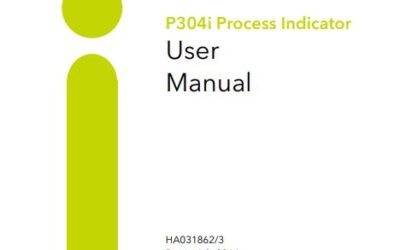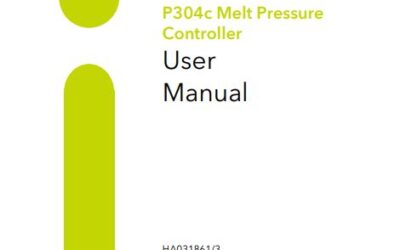PID Temperature Controllers are used when precise temperature control is important. In this article we will describe what they are and the factors to consider when choosing the right PID Temperature Controller for your application.
What is a PID Temperature Controller?
A PID temperature controller is a device that helps keep a specific temperature by using three control actions: proportional, integral, and derivative. The controller measures the temperature and makes adjustments to keep it steady.
The proportional control looks at the temperature difference between the desired level and the actual measurement. It applies an output based on how big the difference is. If the difference is big, the controller applies a larger output.
The integral control adds up the differences between the desired temperature and the actual measurement over time. This helps get rid of ongoing errors and adjusts the output accordingly.
The derivative control predicts how the temperature will change based on how fast the error is changing. It helps keep the control process stable by reducing overshooting and adjusting the output based on how quickly the temperature is changing.
By using these control actions together, the PID controller calculates the output that controls a heating or cooling device to reach and maintain the desired temperature. The controller keeps measuring the temperature, calculating the output, and adjusting it as needed.
PID controllers are used in different industries and applications where precise temperature control is important, like ovens, air conditioning systems, and industrial processes. They are valued because they work well, can be adjusted to different situations, and can handle changes in the system.
What to consider when choosing a controller:
In this video series, New England Temperature Solutions’ President Dominick DeLuca describes factors to consider when choosing a controller.
Size
There are four basic sizes all based around a unit of measure called a DIN. In the temperature control market, most controllers come in four sizes:
- ¼ DIN, measuring 96mm (3.78in) by 96mm (3.78in)
- ⅛ DIN, measuring 48mm (1.89in) by 96mm (3.78in)
- 1/16 DIN, measuring 48mm (1.89in) by 48mm (1.89in)
- 1/32 DIN, 48mm (1.89in) by 24mm (.78in)
All Watlow/Eurotherm temperature controllers have the same basic functionality but more advanced functionality is available in the larger size controllers.
However, the limitation becomes inputs and outputs the smaller the controller size becomes.

Cost vs. Function
Inputs and Outputs
For instance, the basic 1/32 DIN controller only has terminals for one input, power, and two outputs while a fully loaded ¼ DIN controller such as the 2704 has enough terminals for two standard inputs and up to 10 multiple module combinations of inputs and outputs.
The bigger the controller, the more I/O, the more features, and the higher the price.
Selecting the proper controller size will be determined by four things:
- The amount of I/O needed, and I/O will be determined by the process.
- The size of the process. If your process requires you to wear gloves, chances are the 32nd controller will not work for you. (That is unless you decide to prematurely destroy it by changing set points with a pen.)
- The size of the display. How far away do you need to read the display from? And what resolution do you need? Small controllers only have so many digits. If you’re looking for four digit degree resolution, chances are you need to buy a large controller.
- The existing installation. If panel space is not an issue and you’re replacing a quarter DIN or larger controller, you may want to buy a bigger controller. If you don’t, we sell adaptor plates for between $30-$50 to cover the larger holes. If you need to build a panel, you may opt for the smaller controller to save on panel size.
Accuracy
The PID stability and accuracy of most of the controllers are similar on all sizes. However, premium controllers such as the Watlow/Eurotherm 3504 and the 2704 have higher accuracy to meet mil specs and life science regulations such as 21CFR part 11 and heat treat regulations such as AMS2750G and Nadcap.
Inputs
In the old days, you’d have to specify what input you wanted, but now all Watlow/Eurotherm temperature controllers now come with universal inputs. That means that any device with analog input of 0-10Vdc, or 0-20mAdc or 0-50mVdc can be used by the Watlow/Eurotherm controller.
Watlow/Eurotherm controllers take every type of Thermocouple and RTD manufacturer and have proper scaling and cold junction compensation that can be selected automatically.
Linear inputs of 0-10Vdc or 4-20mAdc can be selected. When using the 4-20mAdc inputs, a shunt resistor (typically 2.49 Ohms) is used across the terminals to convert the 4-20mAdc to a mVdc input. When configuring Watlow/Eurotherm, the calculation is done for you if you use our resistor.
Several of our controllers have custom lookup tables available for non-linear inputs. The 2704 even has a logarithmic input for vacuum gauges. The bottom line is that almost any measuring device can be connected to these controllers and configured to display for any engineering unit you require.
Outputs
The Watlow/Eurotherm controllers come with 5 outputs:
- Mechanical Relay
- 120 or 240 Vac Triac Output
- 12Vdc Logic Output
- 4-20mAdc or 0-10Vdc Linear Output
- Valve Actuator Output (AC Triac or Relay) with a slide wire feedback input
Mechanical Relay
The Mechanical Relay is just that, a mechanical switch that will switch 120Vac or 240Vac when the controller tells it to turn on. While they are very basic and simple, if you process turns on and off a lot, they will wear out. They can either fail full on or full off. Neither one of those is a good situation. Typically they are connected to contactors or solenoid valves.
Triac
A Triac works the same way, but instead of being a mechanical switch, it is a solid state device. It can turn on and off a thousand times more than a mechanical relay.
DC Logic Output
Due to Mercury now being considered hazardous waste and frowned upon by industries, many clients are now using SSRs (Solid State Relays) instead of mercury contactors or solenoids. The SSR is turned on with a signal from a DC Logic output. The DC Logic Output provides a 12Vdc output to turn the solid state relay on and off. The solid state relay can be extremely fast, making it a good choice for proportional control of heaters or solenoid valves.
Linear Outputs
Medium to high-end Watlow/Eurotherm controllers come with 0-10Vdc or 4-20mAdc linear outputs. Most of the time, these signals are used to control SCR Power Controllers or valves. The higher the output the more power is applied to the load. On a few Watlow/Eurotherm controllers, we have the ability to control an actuator using slide wire feedback. An actuator moves a damper or a valve to a position. The controller needs to know where the valve is. This is done using a slide wire. Depending on the position of the actuator and a voltage drop across the resistor, the controller can tell where the valve is. There are only a few controllers made in the industry that will accept this type of input/output. Watlow/Eurotherm is one of these companies. This option is available on the 2604, 2704 and 3500 series controllers.
Control Types
This is one of the most complicated and confusing sections of a controller, but we will have a separate video designed to explain proportional, integral and derivative, but there are basically 3 types of control; On/Off Control, PID Control and Valve Control.
On/Off Control works just like the thermostat at your house. The controller is totally on until the temperature setpoint is satisfied. Once the setpoint is satisfied, the controller turns off. There is a deadband between the On/Off section so that you do not end up with what is called chatter. Negative to this type of control is that it has fluctuations and temperature depending upon the load and the amount of power in the system. The positive of this type of control is that it is fairly simple to wire and there is no tuning necessary.
The second most popular type of control is PID. PID stands for proportional, integral and derivative, also known as gain, reset and rate. These terms are defined in a video titled PID & Tuning. Most controllers have auto-tuning. The auto-tune can be configured at start-up or you can initiate it during the middle of the process. For most processes, the auto-tune works very well.
The third type of control is a Valve Actuator type. The Watlow/Eurotherm controllers have a special algorithm for valve actuators. This sets the standard range and timing of the actuator to ensure that the controller and the actuator know exactly what each other is doing.
Alarm Types
There are 4 types of alarms:
- Process Alarm
- Deviation Alarm
- Deviation Band Alarm
- Rate of change Alarm
A process alarm is a specified setpoint. It can be a high process or a low process. Let’s take for instance a 1000 degree process alarm that is set for high. If the temperature exceeds 1000 degrees the alarm contact will open or close depending upon how you have it configured. Once the alarm is acknowledged, the alarm condition will still exist, but will stop flashing on the controller. The alarm condition will disappear once the process goes below 1000 degrees or the controller is no longer in alarm. It will not turn on again until the process goes above 1000 degrees.
There are 2 types of Deviation Alarms. There is a Standard Deviation and a Deviation Band Alarm. The standard deviation is a high or a low deviation. The alarm is set if the temperature deviation from setpoint is reached. If there is a 25 degree deviation alarm, and the setpoint is 1000, the alarm will trigger at 1025 degrees. If it is a low deviation alarm, the alarm will trigger at 975 degrees.
A Deviation Band Alarm is a plus and minus alarm, or a high and a low alarm. If the deviation band alarm is for 25 degrees, and the setpoint is 1000, the alarm will occur at 1025 or 975. Anywhere in the middle, the alarm will not be active.
A Rate Alarm is just that. The alarm is set based on a rate of change. If the temperature changes faster than the desired rate of change, which can be set in seconds or minutes, the control alarm output will open or close.
Digital Communications
There are 6 different types of digital communications:
- Serial RS232
- Serial RS485
- Serial RS422
- Ethernet
- Device Net
- Profibus
The amount of instruments connected to the computer and the protocol of the instruments will determine the type of digital communications you select.
The RS232 communications port can only be used with 1 controller. If you are using more than 1 controller, you need to specify the other types.
The RS485 and RS422 communication protocols are similar in that they are either a 2-wire or 4-wire twisted pair that starts at one controller and daisy chains to the last controller. Typically a Watlow/Eurotherm controller will use a Modbus protocol. A couple of the new Watlow/Eurotherm controllers use ethernet. The ethernet uses Modbus TCP protocol. Please review our other video resources for specific instruments on how to wire any of these communication options.
The Devicenet and Profibus communications allow you to directly connect to either an Allen Bradley PLC via devicenet or to a Siemens PLC via Profibus. The protocols need special cards in a PLC to communicate. If you have any questions about any of these protocols, please call us.
Ramp/Soak
Some controllers have what we call a ramp/soak profile. This option gives you the ability to ramp and dwell or soak at a temperature over a course of time. Options include multiple event outputs. Depending upon your process you may require events. We suggest that you contact us directly when specifying a ramp/soak profile. We have several controllers to do this and depending upon your application, we would determine what model you should use.
At any time, please feel free to contact us at 1-800-848-NETS. You can purchase any of these controllers at eurothermcontrollers.com
Feel free to check out our other resources at nets-inc.com.
If you have any suggestions for training videos, feel free to submit them at nets-inc.com
We recommend these industry leading PID Temperature Controllers:
No Results Found
The page you requested could not be found. Try refining your search, or use the navigation above to locate the post.
How To Wire a Temperature Controller
No Results Found
The page you requested could not be found. Try refining your search, or use the navigation above to locate the post.
No Results Found
The page you requested could not be found. Try refining your search, or use the navigation above to locate the post.



